It’s last year, April 30, Las Vegas, Caesar’s Forum. Melanie Salata-Fitch waits patiently, for one specific NFL draft pick, the same selection, always—the very last one. Her pops, the late Paul Salata, sold the wider sports world on the relevance of that particular selection. He sold it by tying that pick to a tag that accomplished the opposite of its literal meaning. The final NFL draft choice became his vision, Mr. Irrelevant, starting in 1976, adding modest intrigue to the end of what’s now a full-blown, three-day, wall-to-wall-coverage extravaganza.
San Francisco holds the final selection—and, bonus, that was her father’s team. Plus, in the portion of the draft most heavy with exchanges, the 49ers haven’t traded it away. Per tradition, a Salata will announce the choice, which fell to Fitch after her father died in 2021. She turns and sees the last pick in ’22 walking toward her. He’s cute, she thinks. Gotta celebrate cute eyes, right? Sure!
Mr. Cute Eyes is Brock Purdy, which is relevant for a whole lotta reasons. He’s a quarterback, and, for a tradition that celebrates fringe NFL prospects among fringe NFL prospects, QBs tend to receive a little more patience, which often leads to longer (relative) careers. They also, due to the public nature of their careers, tend to participate, willingly and happily, in what’s known as Irrelevant Week, an outgrowth of Mr. Irrelevant, Part II of her father’s vision. Still, Fitch says, “I wasn’t doing any interviews before the season started.”
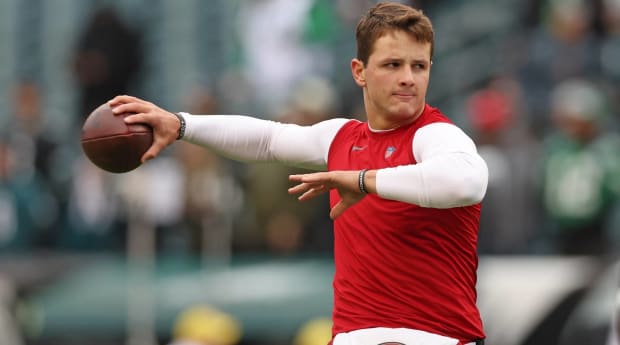
Bill Streicher/USA Today network
First impression: She finds Purdy … really nice. He knows what Irrelevant Week is! He’s excited! His mom lives just down the road from the event’s epicenter, Newport Beach, Calif.! Too good to be true, she thinks. But it is true, all of it. Purdy dives into perhaps the strangest week of his remarkable life.
His grandparents come, as do his parents, brother and sister. Mr. Irrelevants used to bring anyone they wanted. But that number went down in the early 2000s, when one arrived with 63 guests. Purdy refers to his shell crew, all relatives, as my entourage; he understands the intended vibe. He arrives via car, unlike most, who fly in. So he’s not greeted at the airport by banners, cheerleaders and a small crowd. He does receive a street sign with his name on it. He is taken to Knott’s Berry Farm, the amusement park chosen for its minors/49ers ties, including, apparently, one of the mascots, a Mr. Whittles. Purdy plays catch with Mr. Whittles. He’s taken on a pub crawl (Purdy, not Mr. Whittles) and to a pizza parlor, where he makes a pie and tosses it, this attempt more Frisbee than football.
Fitch compares celebrating the final draft choice to picking a random name from any page of a phonebook—if they still had phonebooks, right?—and not halfway celebrating them but really celebrating them, at max volume, in public, for an entire week! Some, she says, “are easier than others.” But she cannot recall another Mr. I who was easier to celebrate than Purdy. For the final part of his relevant-irrelevance week, he chooses learn to surf for his final event. Fitch makes that happen and throws a beach party to boot. There’s surfing and sailing, plus a barbecue feast, before Fitch wishes Mr. Cute Eyes well.
This Mr. Irrelevant, she thinks, might just be all right.
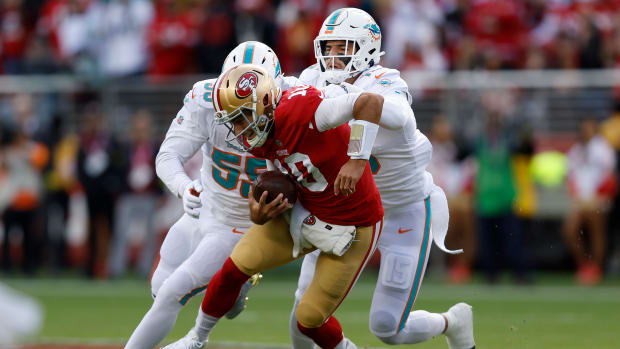
Jed Jacobsohn/AP
The story of Purdy’s 2022 season features skill, personality, good fortune (for him) and misfortune (for others). But don’t mistake his outsized imprint on Mr. Irrelevant history for lucky. Instead, consider the quarterback part of a recent NFL trend involving prospects and their immediate value to teams, which is now higher than ever in later rounds.
The first time Purdy stepped onto a field with Will Hewlett, his private quarterbacks coach, he whistled a high throw in poor weather. What stood out to Hewlett happened next. Purdy concealed any disappointment, if any did exist. Unruffled, he dropped back and tossed an easy, fluid completion.
A rookie season of backhanded compliments started there. Purdy, with the baby face, the smaller (relative) frame and the overall vibe that screamed really good accountant, played far better than first glimpses indicated. He wasn’t as athletic as other shorter quarterbacks such as Russell Wilson or Kyler Murray, but Hewlett found him “explosive in short spaces” due to elite “first-step quickness” and baseball training that made him comfortable throwing on the move. He was intuitive, asked a lot of questions and played with a pocket presence.
Hewlett and Tom Gormely trained Purdy all spring. They made some biomechanical tweaks to Purdy’s motion—focusing on efficiency, bad habits, throwing quickly—but nothing drastic, because, as Iowa State football fans already knew, the kid could play. His completion percentage (67.7% in 48 college games), touchdown-to-interception ratio (81 to 33) and moxie made him a midwestern folk hero, Brocktober and all the rest.
“At no time did we or Brock believe he was irrelevant at all,” Gormely says. Purdy trained with intention. He didn’t mind slinging it, minus the cannon, like Dan Marino, his childhood hero. Purdy’s game featured dynamic elements, Gormely says, further debunking the underdog story, which would have been unheard of for a seventh-round selection 15 years ago.
“I can start in the NFL,” he said at one point, despite some inescapable facts. Like: No Mr. Irrelevant, at quarterback, ever had.
Then, in Week 12, San Francisco hosted Miami, and quarterback Jimmy Garoppolo broke his left foot. The Niners’ initial starter, Trey Lance, was already out after suffering a season-ending ankle injury in Week 2. Gormely, a Dolphins fan, was watching in early December. He saw Purdy trot onto the field, taking the first steps toward an unusual place in NFL history. But worried? No.
Watch the 49ers with fuboTV. Start your free trial today.
Over the final nine weeks of last season, Purdy, when healthy, steered the 49ers’ offense back toward explosive and the team back toward the playoffs. Shanahan didn’t constrict the offense, even. He opened that bad boy up, because it suited Purdy’s skill set better than Garoppolo’s. The comparisons grew, until they seemed borderline absurd. Drew Brees came up a lot. So did another late draft pick, the greatest football player of all time. Reporters pushed these comps mostly, at least in public. Gormely and Hewlett knew how they sounded and were careful not to heap even more pressure onto Purdy’s thin shoulders. But in a group text thread for their Throwing Performance Unit, they wondered the same things.
“Also … Is Brock really Tom Brady,” one wrote.
To which another responded, simply, “Yes.”
To be fair, no one is saying that Purdy will fashion a career in the same GOAT universe. But compare them after one season, when nobody expected much from Brady, either, and Purdy is actually ahead. He started 8–0 when playing significant minutes and won the first starts. By season’s end, he was one of three finalists for AP Offensive Rookie of the Year, alongside a second-round running back (Kenneth Walker, Seahawks) and a first-round wide receiver (Garrett Wilson, Jets). Purdy would tear the ulnar collateral ligament in his throwing elbow against the Eagles in the playoffs, and the twist was wild.
He effectively ended San Francisco’s season due to his absence, Mr. Relevant As All Hell.
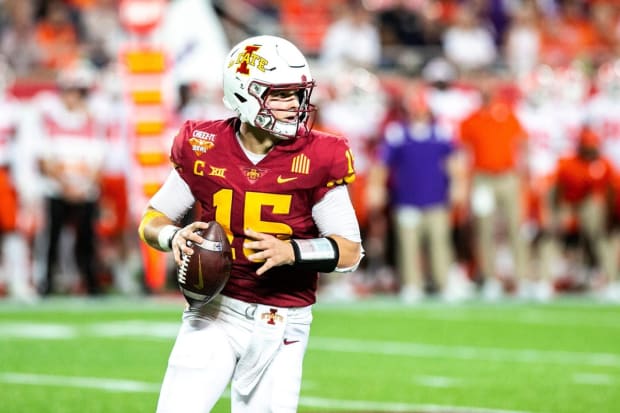
Joseph Cress/Iowa City Press-Citizen/USA TODAY NETWORK
Sage Rosenfels—former Iowa State star, longtime and retired NFL quarterback, astute observer of NFL football—believed, right away, that Purdy would exceed his limited, Mr. Irrelevant expectations. Rosenfels watched all of Purdy’s college games, attending some in person. He saw Purdy lift a middling program beyond realistic expectations. He sometimes broke down game film with Purdy over video conference, so he understood the processing speed in an elite brain. He even realized Purdy’s pull when his mom became obsessed, a proud Brocktober member and, speaking of relevance, a future 49ers fan. The kid reminded Rosenfels of Brees: low-key, talented, more athletic than given credit for, efficient. Iowa State won because of Purdy, just as Purdue won because of Brees.
In light of that, where did evaluations go so wrong? Start with the trend, Rosenfels says, that factors into decisions in more than one way. It deepens the pool, for starters, pushing better, more developed prospects further down draft boards. But the trend is also new-ish, meaning not all teams subscribe to the benefits purported to Sports Illustrated by six separate general managers or personnel executives.
Rosenfels believes the factors in play are clear. Prospects, especially quarterbacks, begin the development process earlier than they did when Rosenfels played (he retired after 2012). Those same prospects—again, especially at quarterback—begin working with private coaches far earlier, too. The vast majority of signal-callers, if not all, employ that type of coach before they throw a pass in college, let alone beginning draft prep. “In my day, quarterbacks sort of figured it out by themselves,” Rosenfels says. “It wasn’t common to have a private coach from age 9.”
It is now, and those same prospects also attend camps that focus on skill development, another boom over the last 10 to 12 years. “They pick up the little things that help them become better, more natural throwers,” Rosenfels says. “Science is involved now. There was no science before.”
More years + more skills + more coaching + more reps. That’s the wider blueprint that Purdy and players like him followed. Many land in variations of the Kyle Shanahan offense, where they’re tasked with making decisions quickly but where the majority of the throws are designated within 10 yards of the line of scrimmage. Often, like Purdy, they come from college offenses that are more complicated than before. Because their offenses are more nuanced and their skill sets are more honed, they should, in theory, arrive more polished and more prepared.
Once prospects at less-than-major programs—like Purdy!—make a roster, they’re not playing with one or two elite skill-position players at most. They’re playing with George Kittle, Deebo Samuel, Christian McCaffrey and Brandon Aiyuk, at the direction of an offensive brain such as Shanahan. “Everything is changing to maximize players,” Rosenfels says. Of quarterback hopefuls specifically, he adds, “Back in the old days, everyone was looking for Troy Aikman—6'4", strong arm, yada, yada. Now, they just look for, How many positives does this guy have? What are they? And how can we use them?”
All of which begins to explain how Purdy dropped to the final pick of the last NFL draft. Evaluators appeared to value what he lacked—prototypical size, easy comparisons to starting QBs—over what he had. If anything, his 46 college starts gave them ammunition to overanalyze and pick apart his skill set. They seemed to focus on his errant throws, while accounting less for who he threw to.
Hence why Purdy’s Mr. I star turn is important, if, as expected, it continues to change how NFL teams evaluate draftable players. By taking Purdy, rather than signing him, the 49ers hold onto his now valuable rights. But he also provided them with a snapshot of why assessing value by traditional methodology, in some, even many, instances, might not be the best approach.
“Athleticism has so many layers to it,” Hewlett says. “A guy like Brock has these fantastic traits, and I still don’t think that, as a whole, the NFL and football in general, have a sure way to evaluate and get that right.”
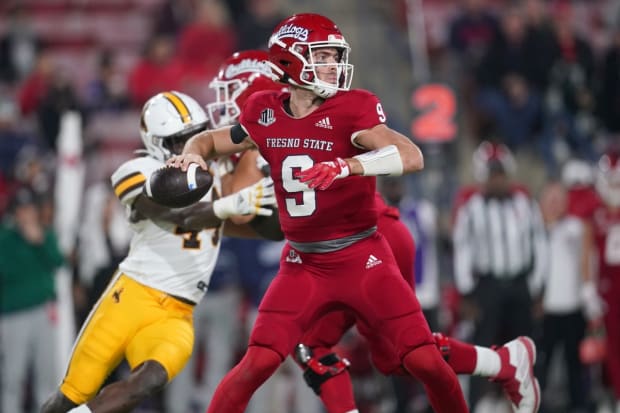
Cary Edmondson/USA TODAY Sports
When considering the factors Rosenfels lays out, a performance coach who trains draft hopefuls, like Erik Jernstrom, can connect theory to the training boom at facilities like his. Modern football, he says, has a year-round cultural influence. He’s aware of children as young as 7 who pay for private coaching. Teenagers seek out influential developers like him, a trainer for Cooper Kupp and Brandin Cooks, among other NFL stars. And, when he watches high school football in his home state of Oregon, he can hardly recognize the caliber of talent compared to his long-ago playing days on the same fields.
So, yes, NFL draft prep has become its own cottage industry. But the prep now extends far beyond the weeks or even months before the first round starts. Jernstrom trains a ton of fringe prospects, but he believes that the gap between their readiness and that of higher picks has winnowed significantly over the last 10 years. “You’re seeing a narrowing of the margin of talent from a seventh-round guy all the way up,” he says.
Perhaps, then, the relevance of the next Mr. Irrelevant—the Texans hold the pick for now, No. 259—should be considered more deeply in football terms. Consider the candidates. There are smaller school stars (such as Shepherd quarterback Tyson Bagent). There are major program cornerstones who don’t project as obvious early selections (think quarterbacks such as BYU’s Jaren Hall, TCU’s Max Duggan, Fresno State’s Jake Haener and UCLA’s Dorian Thompson-Robinson. There are legit stars with physical limitations (Georgia quarterback Stetson Bennett). There are tweeners (Houston quarterback Clayton Tune). And there are non-quarterback candidates (oddsmakers, oddly, like someone from Ohio State at +1000; many point to kicker Noah Ruggles as a smart play). SI reached out to all those players, hoping to interview them about Purdy and late-round draft value. None responded.
Haener, in particular, seems offended by the comparisons. But him saying he doesn’t like being compared to Purdy is grounded in older attitudes that signal less value in the last pick than that last pick is now capable of providing, every single year. Haener is resilient, having started his career at Washington, transferred to Fresno State and stayed when his coach, Kalen DeBoer, left for UW, of all places. Haener is pedigreed, having played for Jeff Tedford, who coached Aaron Rodgers and others. Haener is tough, having broken an ankle in Week 3 last season and played on anyway, while leading the Bulldogs to seven straight wins. And Haener is flat-out talented, having drawn praise from UCLA coach Chip Kelly after a 2021 stomping of the Bruins.
DeBoer laughs over the phone. “I know why you’re bringing up the comparison,” he says, while beginning to list the factors. Smaller frame, for one. College success, for another. Varying projections. Leadership. Smart. Prepared.
He’s talking about Haener. He could be talking about Purdy.
The coach can still recall Haener upon his arrival in Fresno. His motivation stood out. He typed up all his goals—team, individual, in football and outside of it—and emailed the Word document to DeBoer. Haener gave rousing pregame speeches. He sparked late comeback victories. He spent his “free time” studying game film and the playbook. He became, in other words, the perfect projection for Purdy-like. And that is in no way a bad thing.

Erick W. Rasco/Sports Illustrated
By now, many observers view trends in the development of football prospects as entrenched, obvious, a necessity for NFL success. Still, they’re relatively recent, as Chiefs general manager Brett Veach notes in February, three days before Super Bowl LVII. He’s hiking up Camelback Mountain, and it’s steep, the air thin, breathing labored. Yes, the climb is difficult but nowhere close to the path back to another championship game for Kansas City.
That climb began last spring, in advance of the draft. Veach and his personnel team held a bounty of capital—12 selections—but needed to reconfigure a talented roster weighed down by expensive superstar contracts. Veach wanted to make K.C. younger, faster, deeper and replace, as much as possible, two departed cornerstones in wideout Tyreek Hill (traded to Miami) and safety Tyrann Mathieu (left for New Orleans in free agency). With so many aims, every selection mattered; each could mark the difference between failing to optimize another year of Patrick Mahomes’s prime and winning another championship.
When Veach met with reporters last spring, he said he considered that particular draft deep. This owed, in part, to the pandemic that shut down large chunks of the college football season in 2020, giving many future prospects an extra year to develop, on top of extra development in their teens. To Veach, one position—running back—was far deeper, more subterranean, than the rest. On the Chiefs’ board, they laid down between 20 and 25 names—of just running backs worthy of taking in Rounds 6 or 7. In a normal year, they might have eight names there, at most.
Veach liked the kid from Rutgers, Isiah Pacheco, whose 3,039 all-purpose yards in college made for a misleading total. Pacheco ran hard, in the literal sense, like a 5'11", 215-pound bulldozer. He said his childhood—two siblings killed, poverty, uncertainty—formed his style. He just needed more touches.
Here’s where the trend comes in. Ten years ago, if Veach liked a particular running back, he might have considered using a fourth- or fifth-round selection to nab the guy he wanted. But with more than 20 names clustered by similar grades late in a draft where the Chiefs possessed more selections than normal, there was simply no need to rush.
With 12 picks before Mr. Irrelevant, the Chiefs, thrilled with Pacheco’s availability, used their second-to-last choice on him. He nearly doubled his Rutgers’ yardage total, racking up 930 and helping Kansas City overcome injuries at running back.
For teams, like KC, that refuse, philosophically, to mortgage future seasons with funny money contracts, that’s not just a way to sustain success in the modern NFL. It’s really the only way. Pay a few players a ton of money. Fill the roster in around them.
Eight of those 10 draftees wound up playing 3,721 regular-season snaps, good for seventh-most in the NFL. The Chiefs, Veach says, wouldn’t have won their second Super Bowl of this era if not for the restocking—and they don’t have as many options to restock without the trend. As another draft approaches, it’s time to do the same thing all over again.
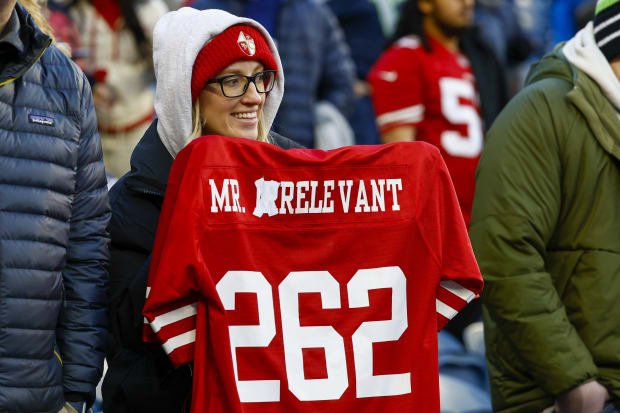
Joe Nicholson/USA TODAY Sports
Paul Salata never saw this coming. How could he, when the impact of Mr. Irrelevant was never the goal? The purpose, instead, was celebrating; in this case, the honor of being drafted at all. Revelry marked something of a Salata speciality. “He would do weird stuff all the time,” his daughter says. For her mother’s birthday, her dad once hired a marching band to parade down the street with a banner, which meant that the musicians would stay for dinner, because he promised them McDonald’s in return. Salata didn’t suggest things to friends like attending luaus; he booked their airfare and hotels and planned out their whole trip. To raise money for charity, he created a fashion show with male models who weren’t models at all. Like himself. He even once guest-starred in a movie. The role? Getting his ass kicked by Moses near a waterfall, his daughter says. Yes, she means Moses in the biblical sense. Dad was also a stuntman.
Mr. I and Irrelevant Week fit perfectly into his ethos: parades and marching bands and press conferences and lavish dinners and yacht excursions or sailing regattas, right from the start. He convinced then commissioner Pete Rozelle that the league should partner with him. He gave out a Lowsman Trophy, the irrelevant Heisman. When one Mr. I missed their scheduled flight, he jumped in, pretending to be Mr. Irrelevant, answering questions from reporters. When the real Mr. I showed up, they simply swapped positions on the stage, and, without explanation, carried on like nothing happened.
Sometimes, Fitch wonders whether deeper meaning didn’t drive her dad. He came from poverty and lost both his parents early into his childhood. Football in general and the NFL in particular paved his path to a better life, gave him a family and a purpose. In creating Mr. Irrelevant, he helped children gain new fields and equipment, helped cancer survivors and wounded veterans. He endowed a scholarship at USC, his alma mater, but for the special teams captain. He told them all the same thing, his trademark phase. Have fun wherever you are. To that end, the irrelevant stokers have missed only one year, due to COVID-19, since the start.
Now, there are power rankings of Mr. Irrelevant. Stories. Short documentaries. Anthologies.
“It surprised him how well received and covered it was nationally, even internationally,” Fitch says.
If only he could see how Purdy changed the Mr. I lens once more. Plenty of Irrelevants carved NFL success. Kicker Ryan Succop ranks sixth all time in points scored and won a Super Bowl in Tampa; fullback Jim Finn also triumphed, with the Giants; wideout Marty Moore proved a solid linebacker and played in a championship game for New England; guard Tyrone McGriff Sr. made the 1980 All-Rookie team. But every one of those guys, there’s a Tim Toone (2010; zero career catches), a Cheta Ozougwu (’11; eight tackles, sack and forced fumble in nine career games) and a Chandler Harnish (’12; no NFL snaps taken), to name a few.
In not even two months near the end of last season, Purdy elevated above them all. Fitch can connect the vibe he projected during Irrelevant Week to how the spotlight didn’t bother him. Hewlett can connect his skill set. Rosenfels can connect his college star turn. Veach can connect the late-round value. And yet, amid all those connections, Purdy also may be changing what Mr. Irrelevant is, what Mr. I can be. He’s the first, Fitch says, to score a touchdown. But the Cinderella story she mentions isn’t exactly right. Purdy belongs—in the NFL, as a starting quarterback (should he recover from the injury) and at the front of a trend that should make the upcoming draft even more interesting and more critical.
All of which is to say: Mr. Irrelevant has never been more relevant.







